Following in the footsteps of Namibia and Panama, this was our third annual Neighbor Nosh! We got a permit to shut down the block, and set up tables and chairs right in the middle of the street. It was so neat to take the neutral space we all use and see every day, and to claim it as a not just a gathering place as with a typical block party, but for sharing a sit-down meal to spend quality time with each other. I encourage anyone to do it even if they’re not forcing a random country’s food upon their neighbors.
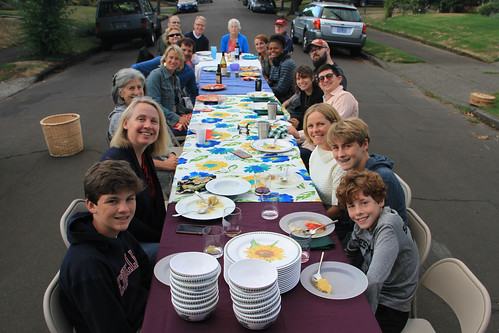
We all agreed that this was the best of the three such meals. Romanian food has a lot of flavor and variety, ranging from sensations like tangy, spicy, and garlicky, to rich, hearty, and comforting, an imprecise contrast which roughly parallels the heavily overlapping Ottoman and Slavic influences. Adventurous foodies and picky kids alike found plenty in this meal to enjoy!
On the side, as accompaniment to everything, we had smântână (the sour cream common to Russia and other Slavic cuisines) and mujdei, which takes many forms but here was a bunch of garlic mashed with salt and a bit of sunflower oil, as pungent as it is simple.
Mămăligă | Cornmeal | Recipe
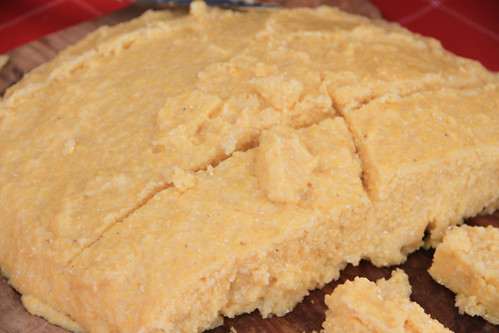
Just like polenta, it’s made out of coarse cornmeal and water. But if you call Romania’s staple starch polenta, this blogger will not be happy. They have a point: basic mămăligă is even simpler than polenta, without the salt and butter and/or cheese that Italians use (though there is a more done-up version like that), and is also cooked to a thicker state. In fact, it’s simply poured onto a board where, thanks to the lack of fat, within a minute it magically congeals into a mass solid enough to slice and hence a fine vehicle for dips or even dipping in soup.
Salată de vinete | Eggplant dip | Recipe
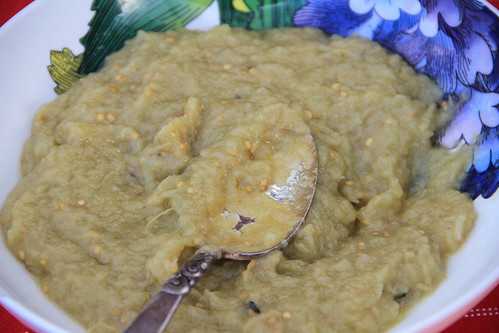
Despite being called a salad, this is really more of a dip or spread. It’s super simple, just roasted peppers with a lot of oil and some lemon juice. I made it two ways, in the food processor and mashed by hand. The first was, as expected, a lot smoother and fluffier, while the hand-mixed version was heavier and more textured. I rather preferred the first, especially because it took a lot less work.
Salată de ardei copţi | Marinated peppers | Recipe
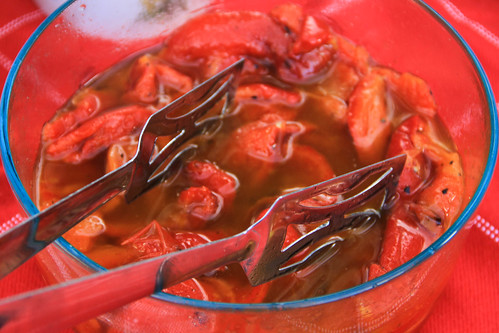
Despite also being called a salad, this is really more of a marinade. It started with a fire sale on red peppers a few months prior, which I threw on the grill that day, peeled, and froze in their charred state. Then I just defrosted them, mixed them in the dressing, and that’s that. Oily and tangy, they’d be great on a crusty bread, but were also just fine with what we had.
Compot | Fruit drink | Recipe

Simmer fruit in water with a bit of sugar, then cool it down. Is it a drink or a snack? Yes! Depending on what fruit you use, this can either be tasty — the cherry version went in an instant — or weird, as evidenced by close to a gallon of leftover grape compot that looked like a vessel of hundreds of alien eyes.
Murături asortate | Assorted pickles | Recipe
From everything I’ve read, pickles are a huge deal in Romania. There are a million different things you can pickle and ways to pickle (I even read about vegetables stuffed with pickles before pickling), but this is perhaps the most basic: put a bunch of veggies in a jar, fill with salty water a few spices, and wait. Classic lacto-ferment, and tasty. The fun part of this one was that thanks to red cabbage, it all turned pink while the cabbage itself lost all color.

Borş de fasole | Bean soup | Recipe, Bors
The two most common Romanian soup recipes online are with meatballs or tripe. The former is just too similar to the filling of cabbage rolls (see below), while the latter just didn’t strike me as the best thing to foist upon two dozen unsuspecting neighbors. While a bean soup is perhaps more classically Moldavian than broadly Romanian, it did seem a good choice to balance things out. Plus it was a chance to try my hand at borş, which is the same word as that Ukrainian beet soup, yet in Romania it refers to a sour fermented liquid made from wheat bran.
I made two parallel pots, one soured with borş and the other with sauerkraut juice. The one with borş was a little more mellow, but they both were quite good, especially with the smoked pork adding richness. And, as with almost all soups, it was even better the next day.
Saramură de pește | Sour fish | Recipe
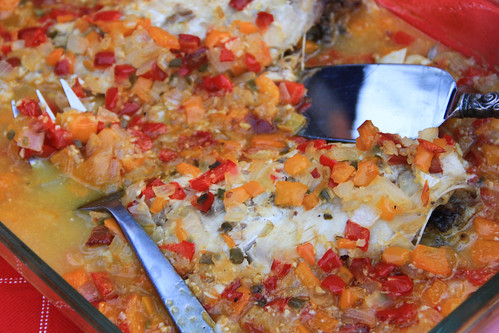
I was afraid this might end up being one dish too many, especially when I had to go to three stores before I found anything approaching carp, which ended up being bass. (For being close to the ocean and with so much river fishing, it’s surprising few places have reliable fish selection and quality in Portland.)
But this ended up tasting really good! And I learned a new cooking technique: lining a pan with salt to keep the fish raised a bit off the pan, so you can get it good and hot but not have to fry it. It might have gone even better if I could have found my coarse salt, but a healthy layer of kosher salt worked ok. Once thus cooked, the fish is baked with a “marinade” of vinegar, veggies, and chilies, and the result is delicious: the fish is firmer than it’d have been if simply poached, and the zesty sauce was a real tongue-tickler.
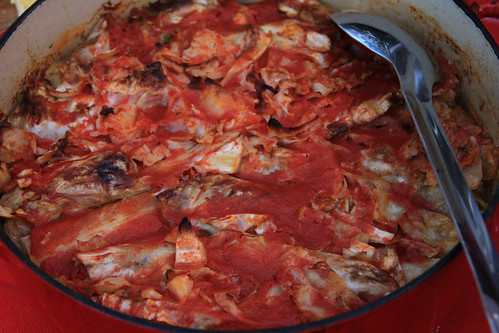
Sarmale | Cabbage rolls | Recipe
After allll that, we get to the sine qua non of Romanian food, the cabbage roll. As with so many treasured national dishes, there are as many variations as there are grandmothers. I pretty much followed the linked recipe, except that I didn’t use as much pork belly as she called for (I found it incredibly hard to chop up, on reflection I should have frozen it a bit), and instead used more ground pork. But I was generous with the smoked meat and bacon, exactly as specified. I managed to make one head’s worth of whole cabbage leaf sauerkraut about ten days in advance, though I couldn’t fit a whole head in the jar so instead I separated the leaves which I then fermented. Fearing that one head wouldn’t be enough, I also used a fresh cabbage, which I softened and separated using a novel technique as described in the recipe: boil the whole head, carefully removing a few leaves with tongs every few minutes until you get to the core.
These were really delicious. I loved what the savory and the dill seed did, just different enough to make it feel like I was eating something distinctive. And the rich meat, with the tangy cabbage, and just enough tomato sauce...really, a great and satisfying combo. Frankly we couldn’t tell much of a difference between fresh and sauerkraut leaves, because I put sauerkraut juice in the fresh leaves’ pot so it all kinda tasted similar.
Given everything else I made, there were, conservatively, 80 rolls left over. So make these, but if you make a lot, have some containers on hand to send home with guests, or bags to toss ‘em in the freezer.
Plăcintă cu mere | Apple cake | Recipe
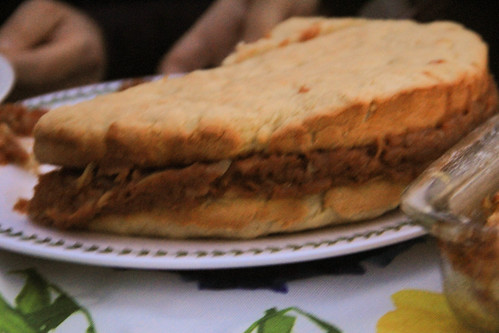
As discussed in the Moldova post, the Romanian name indeed is the same our word “placenta.” Thankfully, this version was a lot better than the one we did for that meal. Instead of a turnover, this recipe is essentially two separately baked cakes sandwiching a filling, and it turned out with more flavor and a better texture. A big thank you to Marisa down the block who made this treat!
Vargabeles | Noodle pudding | Recipe
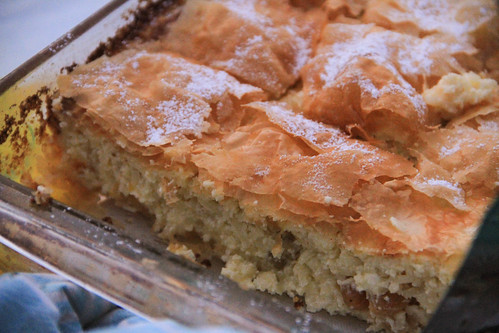
This dish is considered Hungarian, yet it’s commonly eaten in Transylvania in Romania’s north, so it counts. It really reminds me of the classic Ashkenazi Jewish dish named kugel, the major difference being that this one has layers of filo dough to give some extra crisp, while the addition of a little lemon and egg white make it more firmly dessert-like. Our neighbor Betsy did a beautiful job, but also baked way too much, which I didn’t mind because this made for a great breakfast the next few days.